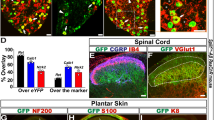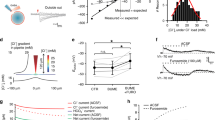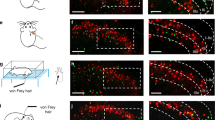Abstract
Noxious stimulation can trigger persistent sensitization of somatosensory systems that involves memory–like mechanisms. Here we report that noxious stimulation of the mollusc Aplysia produces transcription–dependent, long–term hyperexcitability (LTH) of nociceptive sensory neurons that requires a nitric oxide (NO)–cyclic GMP–protein kinase G (PKG) pathway. Injection of cGMP induced LTH, whereas antagonists of the NO–cGMP–PKG pathway prevented pinch–induced LTH. Co–injection of calcium/cAMP–responsive–element (CRE) blocked both pinch–induced LTH and cAMP–induced LTH, but antagonists of protein kinase A (PKA) failed to block pinch–induced LTH. Thus the NO–cGMP–PKG pathway and at least one other pathway, but not the cAMP–PKA pathway, are critical for inducing LTH after brief, noxious stimulation.
This is a preview of subscription content, access via your institution
Access options
Subscribe to this journal
Receive 12 print issues and online access
$209.00 per year
only $17.42 per issue
Buy this article
- Purchase on Springer Link
- Instant access to full article PDF
Prices may be subject to local taxes which are calculated during checkout




Similar content being viewed by others
References
Coderre, T. J., Katz, J., Vaccarino, A. L. & Melzack, R. Contribution of central neuroplasticity to pathological pain: review of clinical and experimental evidence. Pain 52, 259– 285 (1993).
Walters, E. T. Injury–related behavior and neuronal plasticity: an evolutionary perspective on sensitization, hyperalgesia and analgesia. Int. Rev. Neurobiol. 36, 325–427 ( 1994).
Frost, W. N., Castellucci, V. F., Hawkins, R. D. & Kandel, E. R. Monosynaptic connections made by the sensory neurons of the gill– and siphon–withdrawal reflex in Aplysia participate in the storage of long–term memory for sensitization. Proc. Natl. Acad. Sci. USA 82, 8266–8269 ( 1985).
Walters, E. T. Multiple sensory neuronal correlates of site–specific sensitization in Aplysia. J. Neurosci. 7, 408– 417 (1987).
Cleary, L. J., Lee, W. L. & Byrne, J. H. Cellular correlates of long–term sensitization in Aplysia. J. Neurosci. 18, 5988 –5998 (1998).
Billy, A. J. & Walters, E. T. Long–term expansion and sensitization of mechanosensory receptive fields in Aplysia support an activity–dependent model of whole–cell sensory plasticity. J. Neurosci. 9, 1254–1262 (1989).
Schacher, S., Castellucci, V. F. & Kandel, E. R. cAMP evokes long–term facilitation in Aplysia sensory neurons that requires new protein synthesis. Science 240, 1667–1669 ( 1988).
Bacskai, B. J. et al. Spatially resolved dynamics of cAMP and protein kinase A subunits in Aplysia sensory neurons. Science 260, 222–226 (1993).
Dash, P. K., Hochner, B. & Kandel, E. R. Injection of the cAMP–responsive element into the nucleus of Aplysia sensory neurons blocks long–term facilitation. Nature 345, 718–721 (1990).
Kaang, B. K., Kandel, E. R. & Grant, S. G. Activation of cAMP–responsive genes by stimuli that produce long–term facilitation in Aplysia sensory neurons. Neuron 10, 427–435 (1993).
Bartsch, D., Casadio, A., Karl, K. A., Serodio, P. & Kandel, E. R. CREB1 encodes a nuclear activator, a repressor, and a cytoplasmic modulator that form a regulatory unit critical for long–term facilitation. Cell 95, 211– 223 (1998).
Abel, T. & Kandel, E. Positive and negative regulatory mechanisms that mediate long–term memory storage. Brain Res. Rev. 26, 360–378 ( 1998).
Silva, A. J., Kogan, J. H., Frankland, P. W. & Kida, S. CREB and memory. Annu. Rev. Neurosci. 21, 127–148 (1998).
Wang, X. & Robinson, P. J. Cyclic GMP–dependent protein kinase and cellular signalling in the nervous system. J. Neurochem. 68, 443–456 ( 1997).
Gudi, T. et al. Regulation of gene expression by cGMP–dependent protein kinase. Transactivation of the c–fos promoter. J. Biol. Chem. 271, 4597–4600 ( 1996).
Woody, C. D., Swartz, B. E. & Gruen, E. Effects of acetylcholine and cyclic GMP on input resistance of cortical neurons in awake cats. Brain Res. 158, 373–395 (1978).
Arancio, O., Kandel, E. R. & Hawkins, R. D. Activity–dependent long–term enhancement of transmitter release by presynaptic 3',5'–cyclic GMP in cultured hippocampal neurons. Nature 376, 74– 80 (1995).
Niedbala, B., Sanchez, A. & Feria, M. Nitric oxide mediates neuropathic pain behavior in peripherally denervated rats. Neurosci. Lett. 188, 57 –60 (1995).
Nakazawa, K., Karachot, L., Nakabeppu, Y. & Yamamori, T. The conjunctive stimuli that cause long–term desensitization also predominantly induce c–Fos and Jun–B in cerebellar Purkinje cells. Neuroreport 4, 1275–1278 (1993).
Johnston, H. M. & Morris, B. J. N–methyl–D–aspartate and nitric oxide regulate the expression of calcium/calmodulin–dependent kinase II in the hippocampal dentate gyrus. Mol. Brain Res. 31, 141–150 (1995).
Belsham, D. D., Wetsel, W. C. & Mellon, P. L. NMDA and nitric oxide act through the cGMP signal transduction pathway to repress hypothalamic gonadotropin–releasing hormone gene expression. EMBO J. 15, 538 –547 (1996).
Gudi, T., Lohmann, S. M. & Pilz, R. B. Regulation of gene expression by cyclic GMP–dependent protein kinase requires nuclear translocation of the kinase: identification of a nuclear localization signal. Mol. Cell. Biol. 17, 5244–5254 (1997).
Harootunian, A. T. et al. Movement of the free catalytic subunit of cAMP–dependent protein kinase into and out of the nucleus can be explained by diffusion. Mol. Biol. Cell 4, 993– 1002 (1993).
Fantozzi, D. A. et al. Thermostable inhibitor of cAMP–dependent protein kinase enhances the rate of export of the kinase catalytic subunit from the nucleus. J. Biol. Chem. 269, 2676– 2686 (1994).
Scholz, K. P. & Byrne, J. H. Intracellular injection of cAMP induces a long–term reduction of neuronal K+ currents. Science 240, 1664–1666 ( 1988).
Clatworthy, A. L. & Walters, E. T. Rapid amplification and facilitation of mechanosensory discharge in Aplysia by noxious stimulation. J. Neurophysiol. 70, 1181– 1194 (1993).
Walters, E. T., Byrne, J. H., Carew, T. J. & Kandel, E. R. Mechanoafferent neurons innervating tail of Aplysia. I. Response properties and synaptic connections. J. Neurophysiol. 50, 1522–1542 (1983).
Walters, E. T., Alizadeh, H. & Castro, G. A. Similar neuronal alterations induced by axonal injury and learning in Aplysia. Science 253, 797–799 (1991).
Gunstream, J. D., Castro, G. A. & Walters, E. T. Retrograde transport of plasticity signals in Aplysia sensory neurons following axonal injury. J. Neurosci. 15, 439–448 ( 1995).
Ambron, R. T., Dulin, M. F., Zhang, X.–P., Schmied, R. & Walters, E. T. Axoplasm enriched in a protein mobilized by nerve injury elicits memory–like alterations in Aplysia neurons. J. Neurosci. 15, 3440– 3446 (1995).
Liao, X., Gunstream, J. D. Lewin, M. R., Ambron, R. T. & Walters, E. T. Activation of protein kinase A contributes to the expression but not the induction of long–term hyperexcitability caused by axotomy of Aplysia sensory neurons. Neuroscience (in press).
Deisseroth, K., Heist, E. K. & Tsien, R. W. Translocation of calmodulin to the nucleus supports CREB phosphorylation in hippocampal neurons. Nature 392, 198–202 (1998).
Bernabeu, R. et al. Further evidence for the involvement of a hippocampal cGMP/cGMP–dependent protein kinase cascade in memory consolidation. Neuroreport 8, 2221–2224 (1997).
Kendrick, K. M. et al. Formation of olfactory memories mediated by nitric oxide. Nature 388, 670–674 (1997).
Meulemans, A. et al. A nitric oxide synthase activity is involved in the modulation of acetylcholine release in Aplysia ganglion neurons: a histological, voltammetric and electrophysiological study. Neuroscience 69, 985–995 (1995).
Jacklet, J. W. Nitric oxide is used as an orthograde cotransmitter at identified histaminergic synapses. J. Neurophysiol. 74, 891– 895 (1995).
Floyd, P. D., Moroz, L. L., Gillette, R. & Sweedler, J. V. Capillary electrophoresis analysis of nitric oxide synthase related metabolites in single identified neurons. Anal. Chem. 70, 2243–2247 (1998).
Novak–Hofer, I., Lemos, J. R., Villermain, M. & Levitan, I. B. Calcium– and cyclic nucleotide–dependent protein kinases and their substrates in the Aplysia nervous system. J. Neurosci. 5, 151–159 (1985).
Abel, T. et al. Genetic demonstration of a role for PKA in the late phase of LTP and in hippocampus–based long–term memory. Cell 88, 615–626 ( 1997).
Martin, K. C. et al. MAP kinase translocates into the nucleus of the presynaptic cell and is required for long–term facilitation in Aplysia. Neuron 18, 899–912 ( 1997).
Impey, S. et al. Cross talk between ERK and PKA is required for Ca2+ stimulation of CREB–dependent transcription and ERK nuclear translocation. Neuron 21, 869–883 ( 1998).
Manseau, F., Sossin, W. S. & Castellucci, V. F. Long–term changes in excitability induced by protein kinase C activation in Aplysia sensory neurons. J. Neurophysiol. 79, 1210–1218 (1998).
Tao, X., Finkbeiner, S., Arnold, D. B., Shaywitz, A. J. & Greenberg, M. E. Ca2+ influx regulates BDNF transcription by a CREB family transcription factor–dependent mechanism. Neuron 20, 709–726 (1998).
Hardingham, G. E., Chawla, S., Johnson, C. M. & Bading, H. Distinct functions of nuclear and cytoplasmic calcium in the control of gene expression. Nature 385, 260– 265 (1997).
Mackey, S. L., Kandel, E. R. & Hawkins, R. D. Identified serotonergic neurons LCB1 and RCB1 in the cerebral ganglia of Aplysia produce presynaptic facilitation of siphon sensory neurons. J. Neurosci. 9, 4227–4235 (1989).
Ocorr, K. A. & Byrne, J. H. Membrane responses and changes in cAMP levels in Aplysia sensory neurons produced by serotonin, tryptamine, FMRFamide and small cardioactive peptide b (SCP b). Neurosci. Lett. 55, 113–118 ( 1985).
Dale, N., Kandel, E. R. & Schacher, S. Serotonin produces long–term changes in the excitability of Aplysia sensory neurons in culture that depend on new protein synthesis. J. Neurosci. 7, 2232–2238 (1987).
Acknowledgements
This work was supported by grants NS35979 and NS35882 from the National Institute for Neurological Disorders and Stroke. We thank R.T. Ambron, P.T. Kelly, X. Liao, and F. Murad for suggestions, and C. Brou and G. Rumbly for assistance.
Author information
Authors and Affiliations
Corresponding author
Rights and permissions
About this article
Cite this article
Lewin, M., Walters, E. Cyclic GMP pathway is critical for inducing long–term sensitization of nociceptive sensory neurons. Nat Neurosci 2, 18–23 (1999). https://doi.org/10.1038/4520
Received:
Accepted:
Issue Date:
DOI: https://doi.org/10.1038/4520
This article is cited by
-
Presynaptic NMDARs on spinal nociceptor terminals state-dependently modulate synaptic transmission and pain
Nature Communications (2022)
-
Immediate-Early Genes Detection in the CNS of Terrestrial Snail
Cellular and Molecular Neurobiology (2020)
-
Antinociceptive effect of Lonchocarpus araripensis lectin: activation of l-arginine/NO/cGMP/K+ATP signaling pathway
Inflammopharmacology (2020)
-
Family of CNP neuropeptides: common morphology in various invertebrates
Cell and Tissue Research (2011)
-
GTP cyclohydrolase and tetrahydrobiopterin regulate pain sensitivity and persistence
Nature Medicine (2006)



